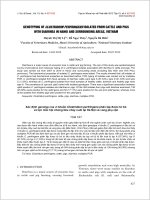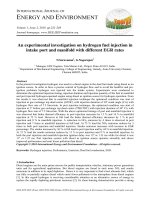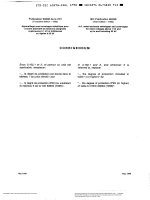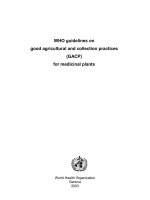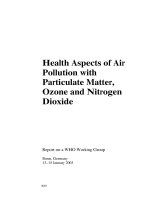HYDROGEN TRANSMISSION/STORAGE WITH METAL HYDRIDE-ORGANIC SLURRY AND ADVANCED CHEMICAL HYDRIDE/HYDROGEN FOR PEMFC VEHICLES ppt
Bạn đang xem bản rút gọn của tài liệu. Xem và tải ngay bản đầy đủ của tài liệu tại đây (1.87 MB, 14 trang )
HYDROGEN TRANSMISSION/STORAGE WITH
METAL HYDRIDE-ORGANIC SLURRY
AND
ADVANCED CHEMICAL HYDRIDE/HYDROGEN
FOR PEMFC VEHICLES
Andrew W. McClaine, Dr. Ronald W. Breault, Christopher Larsen,
Dr. Ravi Konduri, Jonathan Rolfe, Fred Becker, Gabor Miskolczy
Thermo Technologies, a Thermo Electron Company
45 First Avenue, Waltham, MA 02454-9046
Abstract
This paper describes the work performed on two programs supported in part by the U.S.
Department of Energy. These programs are aimed at evaluating the potential of using slurries of
chemical hydrides and organic liquids to store hydrogen. The projects have been very successful
in meeting all project objectives. After a detailed analysis of chemical hydrides, lithium hydride
was selected for use in these programs. Lithium hydride has been prepared as a slurry with light
mineral oil and a dispersant and has been found to be stable for long periods of time at
atmospheric temperatures and pressures. We have demonstrated that the lithium hydride slurry
can be mixed with water to produce hydrogen on demand. Reactions between the lithium hydride
slurry and water take place rapidly and completely. The resulting lithium hydroxide can be
recycled either by electrolytic methods or by a carbo-thermal process. Experiments with the
carbo-thermal process indicate that the regeneration of lithium hydride can be accomplished at
temperatures of 1500°K or less enabling the use of economically acceptable furnace materials. A
cost analysis of the regeneration process indicates that the process should be cost competitive
with hydrogen produced from natural gas and stored as a liquid or a highly compressed gas.
Proceedings of the 2000 U.S. DOE Hydrogen Program Review
NREL/CP-570-28890
NOTICE
This Technical Progress report was prepared with the support of the U.S. Department of Energy
(DOE) Award Nos. DE-FC02-97EE50483, “Advanced Chemical Hydride -Based Hydrogen
Generation/Storage System For PEM Fuel Cell Vehicles”, and DE-FC36-97GO10134,
“Hydrogen Transmission/Storage With A Metal Hydride/Organic Slurry”. However, any
opinions, findings, conclusions, or recommendations expressed herein are those of the author(s)
and do not necessarily reflect the views of DOE.
This report was prepared as a result of work sponsored, in whole or in part, by the South Coast
Air Quality Management District (AQMD). The opinions, findings, conclusions, and
recommendations are those of the author and do not necessarily represent the views of AQMD.
AQMD, its officers, employees, contractors, and subcontractors make no warranty, expressed or
implied, and assumes no legal liability for the information n this report. AQMD has not approved
or disapproved this report, nor has AQMD passed upon the accuracy or adequacy of the
information contained herein.
INTRODUCTION
Objective
We refer to these two programs as the Transportation/Storage Program and the Vehicle Program.
The objective of the Transportation/Storage Program is to demonstrate the technical viability and
economic attractiveness of chemical hydride slurry based hydrogen generation/storage systems.
This program is intended to take a broad view of the entire chemical-hydride hydrogen-storage
cycle. Technical validations and economic analyses are the primary focus of the program.
The objective of the Vehicle Program is to demonstrate a prototype storage and delivery system
for vehicular applications. In this program, we are taking a more detailed look into the ability of
the chemical hydride slurries to store hydrogen for PEM fuel cell applications in vehicles.
The programs are intended to answer the following questions:
• Can the reaction rate of a chemical hydride with water be controlled to provide a safe and
stable storage and hydrogen production process utilizing a slurry based approach?
• Are the physical properties of the reactants and products acceptable for transportation and
bulk storage systems?
• Can a cost effective design of a storage and hydrogen production system be made to meet the
energy density criteria for transportation applications?
• Can a hydroxide-to-hydride regeneration system design be identified that is able to produce
hydrogen at a cost competitive with present fuels?
Technical Concept
The concept behind the use of chemical hydrides is that when the chemical hydrides are mixed
with water they will produce hydrogen. Table 1 displays several of the chemical hydrides
evaluated for use as part of these investigations. Lithium hydride produces hydrogen with a
relatively high gravimetric density. In considering a recyclable process, one of the important
issues is the ability to regenerate the chemical hydride. We selected lithium hydride because it
was a mono-metal hydride rather than a bi-metal hydride. We felt that it would be easier to
reduce a mono-metal hydroxide than to separate and reduce a multi-metal hydroxide. An
additional consideration is that many of the hydroxides form hydrates. Lithium hydroxide forms
a mono-hydrate. Many of the bi-metal hydrides for multi-hydrates when reacted with water. The
lithium hydroxide hydrate decomposes when it is heated above the temperature of boiling water.
Many of the bi-metal hydroxide hydrates do not decompose until they are heated to quite high
temperatures.
Table 1 - Chemical Hydrides and Their Gravimetric Densities
CaH
2
+ 2 H
2
O
MgH
2
+ 2 H
2
O
HH
LiH + H
2
O
LiBH
4
+ 4 H
2
O
NaBH
4
+ 4 H
2
O
Ca(OH)
2
+ 2 H
2
Mg(OH)
2
+ 2 H
2
LiOH + H
2
LiOH + H
3
BO
3
+ 4 H
2
NaOH + H
3
BO
3
+ 4 H
2
Chemical Reaction
Gravimetric Density, %H2
9.6%
15.3%
25.2%
37.0%
21.3%
(Hydride Only)
The process envisioned is that lithium hydride will be prepared as a slurry at centralized plants.
The slurry will be pumped into tanker trucks or pumped through pipes to distribution centers
where it will be loaded into vehicles or carried to storage vessels in homes, business, or industry.
When hydrogen is required, the chemical hydride slurry will be mixed with water to produce a
high quality hydrogen that can be used in fuel cells. The resulting hydroxide waste product will
be picked up when the next delivery is made and transported back to the regeneration plant
where it will be separated from the mineral oil and where the lithium hydroxide will be
regenerated to lithium hydride.
Slurry Concept
A slurry is a mixture of a solid and a liquid to make a pumpable mixture. The main issue in
preparing a slurry of a solid is to distribute the solid in the liquid in such a way that the solid
does not settle out. We have selected light mineral oil in which to suspend finely ground lithium
hydride. A dispersant is used to prevent the particles from settling out of the suspension. Figure 1
displays a conceptual view of the dispersant action. The dispersant is made with an anchor group
and a lyophile. The anchor group attaches to the particle and the lyophile streams outward
forming a set of tendrils that fend off other particles and slow the movement of the particles
within the mineral oil. Particles are typically about 20 microns in diameter.
A major feature of the use of mineral oil to form the slurry is that it forms a protective coating
around the particle that slows the movement of water toward the particle. Figure 2 diagrams this
effect. This protective coating allows the lithium hydride to be safely handled and stored in the
air without absorbing moisture from the air. It also slows the kinetics of the reaction allowing the
development of reaction vessels to mix the hydride with water for releasing hydrogen.
Figure 1 - Chemical Hydride Slurry
H
2
O
H
2
O
Hydride
Oil
Figure 2 - Rate Limiting Reaction
Kinetics
Over the past couple of years, we have developed the ability to produce lithium hydride slurries
in a nearly continuous operation. Figure 3 is a picture of a 3 gallon batch of lithium hydride
slurry being poured into a storage vessel that we were using in the vehicle program. This is 60%
lithium hydride in mineral oil with a dispersant to maintain the slurry properties. The viscosity of
the slurry is about 2000 cp. This slurry is stable for several weeks or more.
Figure 3 - Lithium Hydride Slurry
An important feature of the slurry is its ability to protect the lithium hydride from inadvertent
exposure to water or water vapor. If allowed to, powdered lithium hydride will absorb water
vapor from the air. The reaction of the water vapor and the hydride produces hydrogen and heat.
If the day is sufficiently humid, the heat will build up until it ignites the hydrogen. When mixed
with mineral oil, the hydride cannot absorb moisture rapidly enough to be a hazard. In addition,
because mineral oil has such a high vapor pressure, the mineral oil actually prevents the ignition
of the lithium hydride from open flames. Figure 4 is a sequence of photographs of a test
performed with a propane torch. A spoon full of lithium hydride slurry was placed in our fume
hood. The flame from the torch did not light the slurry when passed near. Gasoline would have
ignited. When the flame was held on the slurry for sufficient time, some of the mineral oil
evaporated and burned. But the flame went out when the torch was removed.
Figure 4 - Flame Test with LiH Slurry
TRANSPORTATION/STORAGE PROGRAM
The focus of our attention in the Transportation /Storage Program during the past year has been
to better understand the regeneration process. We have performed a large number of tests with a
controlled atmosphere high-temperature furnace that we built for this application. We have also
performed a preliminary system design and economic analysis of the regeneration process to
identify the relative cost of hydrogen that can be expected from a chemical-hydride hydrogen-
storage system.
Regeneration Process
The proposed regeneration process is a carbo-thermic reduction process based on the use of low
cost carbon from coal or biomass. The objective is to have zero net carbon dioxide emissions
from the regeneration plant by capturing the highly concentrated carbon dioxide stream leaving
the plant for sequestration. Regeneration will be performed in centralized plants much like
refineries using technologies synergistic with blast, aluminum reduction, and glass furnaces.
Figure 5 is a diagram showing the regeneration process that was evaluated. Figure 6 shows a
simplified ASPEN Plus process flow diagram. Lithium hydroxide and carbon are fed to a radiant
reduction reactor where they are heated to 1350°K. During this reaction, hydrogen and carbon
monoxide are released and lithium is melted. We have assumed that this reduction process is
about 50% effective so the lithium oxide that is not reduced is returned to the reactor. Hydrogen
and carbon monoxide are separated from the lithium and from each other. Carbon monoxide is
put through a shift reaction to form carbon dioxide and hydrogen. The hydrogen is used to
produce electric power and lithium hydride.
LiOH (l) + C (s)
→→
Li (l,g) + CO (g) + H
2
(g)
Carbon Source
LiOH
Recycle
Li
LiH to Distributed H2 Use
Such as Transportation PEM
Fuel Cell Vehicles
CO
H2
H2 & CO
H2 to EnergyPlex
Fuel Cell
H2O
CO2 & H2
CO2 for Sequestration
Fuel
Low NOx
Burner
Heat
Release
Zone
Staging
Air
Ports
Slag
LiOH from
Distributed Use
LiOH, Li, H2 & CO
Radiant
Reduction
Reactor
Figure 5 - Lithium Hydride Regeneration Process
140
298 K
LiOH
(s)
LOH
(s)
950 K
LiOH
(l)
Q2 = 701 MJ
Q2 = 26 MJ
Carbon
210
1350 K
Li
(v),
, Li
(l)
H2, CO
Li
(l)
Li
(l)
170
950 K
H2, CO
Q3
46
950 K
LiH
H2
CO
70
298 K
Carbon
1
2
3
4
5
6
7
8
9
F
E
D
C
B
A
J
I
H
G
• Plant size- 6.4 billion Btu/hr
– Service 250,000 cars
–
13 tons H
2
/hr
–
1876 MW
t
– 1/3 size of First FCC unit
– 1/25 size of Today’s FCC units
• Equipment list
– A - Carbon Preheater
–
B - LiOH Preheater
–
C - LiOH Melter
– D - LiOH Reduction Reactor
– E - High T- Condenser
– F - Low T- Condenser
– G - Membrane Separator
– H - Hydride Reactor
–
I - CO Burner
–
J - Air Preheater
• Flow rates - metric tons/hr
Figure 6 - Simplified ASPEN Plus Process Flow Sheet
A series of experiments were performed to verify that regeneration takes place at the
temperatures desired. Equilibrium thermochemical calculations showed that the reduction of
lithium hydroxide with carbon typically takes place at temperatures above 1800°K except when
the carbon monoxide formed is swept away from the reaction. Figure 7 shows pictorially the
effect of removing CO from the reaction zone. By removing the CO, the reaction is allowed to
proceed toward completion at lower temperatures. Figure 8 shows the high temperature
controlled atmosphere furnace used for the experiments.
0
0.2
0.4
0.6
0.8
1
500 1000 1500 2000
Temperature (K)
Conversion of LiOH to Li
Figure 7 - Effect of Removing CO from LiOH/C Reaction
Figure 8 - High Temperature Controlled Atmosphere Furnace
Figure 9 displays some of the data collected during the test program and confirms the hypothesis
of the regeneration process. It can be seen that the analytical result appears to be supported by
the data collected.
0
0.1
0.2
0.3
0.4
0.5
0.6
0.7
0.8
0.9
1
800 900 1000 1100 1200 1300 1400 1500 1600
Temperature (K)
Fraction Converted to Lithium
Analytic Prediction
Data LiOH/C Reaction
Data Li2O/C Reaction
C/Li = 10.7
C/Li = 21.1
C/Li = 21.1
C/Li = 1.3
C/Li = 1.1
C/Li = 2.0
C/Li = 2.0
C/Li = 2.5 C/Li = 2.0
C/Li = 1.9
C/Li = 4.6
C/Li = 4.5
Figure 9 - Data Collected from High Temperature Furnace Experiments
Economic Analysis
An economic analysis was performed for the regeneration process described above to determine
the cost of hydrogen to be expected. Table 2 displays the assumptions used in the economic
analysis. The analysis began with a preliminary design of the various components required in the
process.
Table 2 - Assumptions Used in Economic Evaluation
Capital $ 58.8 Million
Carbon Variable
Labor
Operators 25 at $35,000/yr
Super. & Cleric. 15% of Operators
Mainten. & Repairs 5% of Capital
Overhead 50% of Tot. Lab. + Mtnc.
Local Tax 2% of Capital
Insurance 1% of Capital
G&A 25% of Overhead
Fed. and State Tax 38% of Net Profit
We found this process to be sensitive to the cost of carbon. However, carbon sources appear to
be available at costs that will make this process economical. Figure 10 displays the results of our
analyses for two size plants. The first plant would serve about 250,000 cars per day. The larger
plant would serve about 2,000,000 cars per day.
6
7
8
9
10
11
12
13
50 60 70 80 90 100 110 120 130 140 150
Carbon Price ($/ton)
Hydrogen Price ($/106 Btu)
Early Introduction Scale - 13 ton H
2
/hr
Commercial Scale - 104 ton H
2
/hr
Figure 10 - Results of Economic Analysis
Figure 11 displays the cost of hydrogen from the lithium hydride slurry system and other
systems. When compared to the cost of stored hydrogen form other production methods, the
chemical hydride slurry approach appears to be very competitive. It is even competitive to the
cost of tax free gasoline.
7.75
8.73
5.9
9.59
13.26
18.8
11.83
15.52
19.19
24.73
13.25
16.94
20.61
26.15
0
5
10
15
20
25
30
LiH
Regeneration
Gasoline CH4 Steam
Reforming
Partial
Oxidation
Texaco Gasifier Water
Electrolysis
H2 Cost, $/10
6
Btu
Slurry, $80/ton carbon
Gasoline, Tax Free
H2 Production Cost
Liquid H2
H2 Gas at 5000psi
Range
$ 150/ton C
$ 50/ton C
Figure 11 – Cost of Stored Hydrogen as a Chemical Hydride and by Conventional
Methods
VEHICLE PROGRAM
The focus of our attention in the Vehicle Program during the past year has been the completion
of the demonstration of the mobile chemical-hydride hydrogen generator. To satisfy the goals of
the program, the hydrogen generator must demonstrate that it can produce 3 kg/hr of hydrogen,
and that it can meet or exceed the gravimetric density goal of 3355 Wh/kg and the volumetric
density goal of 929 Wh/l.
The chemical-hydride hydrogen-storage system developed during this program has achieved all
its goals. An advanced system design based on the developed system and recycling water from
the fuel cell would have a gravimetric energy density of 3364 Wh/kg and a volumetric energy
density of 1954 Wh/l. The system has been demonstrated to follow the hydrogen demand rapidly
and to produce in excess of the 3 kg/hr hydrogen flow rate target.
Hydrogen Generator Design
The hydrogen generator design is made up of storage vessels for the lithium hydride slurry and a
small amount of water, pumps for both the slurry and the water, a mixing reactor, a heat
exchanger, and a hydroxide storage tank. Figure 12 is a diagram of the design. Figure 13 is a
picture of the prototype hydrogen generator after one of its final test sequences. The reactor is a
tube with an auger/mixer running through it. Hydride slurry and water are pumped into the
reactor at one end. The auger/mixer moves this mixture through the reactor and mixes it as it is
being moved. Excess water is evaporated, absorbing and carrying the heat of reaction out of the
reactor with the hydrogen. Hydrogen and water vapor are separated from the hydroxide product
in the head of the hydroxide tank. The water vapor is condensed in the heat exchanger.
Condensed water is returned to the water circuit and hydrogen is delivered to the fuel cell.
Hydroxide
Hydride Reactor
Hydrogen to
Fuel Cell
Waste Heat
Transferred
to Air
Hydride
Pump
Water
Condensed Water Return
Heat
Exchanger
Figure 12 - Diagram of the Hydrogen Generation System
Figure 13 - Picture of the Prototype Hydrogen Generator
Hydrogen Generator Performance
Figure 14 shows the hydrogen and hydride slurry flow rates during a typical test of the system.
During this test, the maximum flow rate was a little over 2 kg/hr of hydrogen. An important
thing to note is the rapid rise in hydrogen flow rate with increases of the slurry and the rapid drop
in the hydrogen flow rate with decreases of the slurry. By having the hydrogen flow stop when
the hydride slurry flow stopped, we were assured that the mixing and reaction in the reactor were
complete.
0
10
20
30
40
50
60
70
80
90
100
34 36 38 40 42 44
Time (minutes)
Hydride Flow (gm/min)
0
5
10
15
20
25
30
35
40
Hydrogen Flow (kW
th
)
Hydrogen
LiH Slurry
Figure 14 - Data Showing the Slurry and Hydrogen Flow Rates
Water pump
Reactor
Hydroxide Tank
Slurry pump
Slurry pump
Quality of the Hydrogen
In order to be acceptable in a fuel cell, the hydrogen produced from the lithium hydride slurry
reactor must have very low concentrations of carbon monoxide. Fuel cell researchers have noted
that the concentration of carbon monoxide must be less than 10 ppm.
Measurements were made during one test of the hydrogen leaving the system at points before
and after a carbon filter. Table 3 displays the results of these measurements. In both
measurements, the carbon monoxide measurements showed that levels were well below the
tolerable levels of a PEM fuel cell. Also measured were concentrations of oxygen, nitrogen,
carbon dioxide, mineral oil, and hydrocarbons. The ratio of oxygen to nitrogen was the same as
that of air and was different in each measurement indicating that air contamination may have
occurred during the measurement process. Measurements of mineral oil and hydrocarbons were
both low. Carbon dioxide was also low. One possible source of the carbon dioxide is from the
water used in the system. Untreated tap water was used in all our experiments.
Table 3 - Measured Contaminants in Hydrogen
Before Carbon Trap - CO2 = 2.4 ppm CO = 1.5 ppm
O2 = 25 ppm Oil = 0.1 ppm
N2 = 95 ppm HC = 1.2 ppm
After Carbon Trap - CO2 = 0.7 ppm CO = 0.1 ppm
O2 = 10 ppm Oil = 0.1 ppm
N2 = 40 ppm HC = 0.8 ppm
As expected the carbon monoxide and hydrocarbons were lower after having passed through a
carbon filter. The results of this test indicate that a carbon filter is probably not necessary for this
system.
SUMMARY/CONCLUSIONS
In summary, the lithium hydride slurry approach for storing hydrogen provides a viable
alternative to hydrogen storage as liquid hydrogen or highly compressed hydrogen. Storage
densities are higher than those for metal hydrides. The gravimetric energy density of 60%
lithium hydride slurry is 5110 Wh/kg or 15.3% hydrogen. The volumetric energy density is
3937 Wh/l or 118 kg H
2
/m
3
. This is more than twice the volumetric energy density of liquid
hydrogen and it is at ambient pressure and temperature. The slurry is easily pumped and can be
reacted with water with mixing to produce hydrogen on demand.
The mobile generator developed for the vehicle program has been shown to produce hydrogen on
demand with complete reaction occurring in the reactor volume. Hydrogen production has been
measured up to 3 kg/hr. Based on the prototype generator design, an advanced design is
anticipated to provide a gravimetric energy density of 3361 Wh/kg and a volumetric energy
density of 1954 Wh/l assuming that the water from the fuel cell is condensed and used to
produce hydrogen in the hydride reactor.
The cost of hydrogen resulting from the carbo-thermal regeneration of the lithium hydroxide to
lithium hydride is estimated to range from $6.04 for carbon costing $50/ton to $11.30 for carbon
costing $150/ton. This is competitive with hydrogen produced by natural gas and stored as a
liquid.
The chemical hydride slurry approach provides other desirable features. The slurry protects the
hydride from accidental contact with moisture in the atmosphere or otherwise. Hydrogen
produced by the reaction of the slurry with water can be performed at elevated pressures
allowing additional power to be generated from the exhaust hydrogen/steam from the reactor
and/or allowing the exhaust hydrogen/steam to be used to pressurize air for a more compact fuel
cell. Production of hydrogen at elevated pressures also allows the components of the hydrogen
generator to be reduced in size.
ACKNOWLEDGMENTS
The authors would like to thank DOE for its support on these two programs. We would also like
to thank the Southern Illinois University and Thermo Technologies for co-funding the Hydrogen
Transportation/Storage Program and the California South Coast Air Quality Management
District and Thermo Technologies for co-funding the Hydrogen Vehicle Program.
We would also like to thank Ford Motor Company, Air Products, and Morton International for
participating in our technical review panel.
